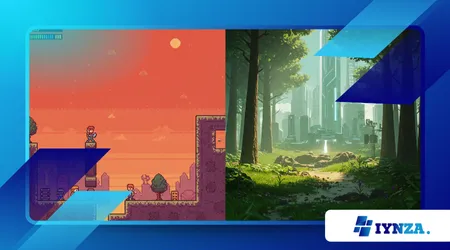Pixel Art vs. 3D Graphics: Why Indie Developers Still Love 8-bit Style

If modern hardware can render ultra-realistic characters and environments, why are so many indie developers still choosing blocky pixels and 8-bit charm? At a glance, it may seem like a step backward. But in the debate over Pixel Art vs. 3D graphics, the preference for pixel-based design has less to do with nostalgia and more to do with control, expression, and identity.
Anúncios
For indie studios, especially those with small teams or solo developers, the decision goes far beyond visual aesthetics. It influences workflow, performance, storytelling, and ultimately, the way players connect with the game.
This article explores why pixel art remains a cornerstone of indie game design—even in a landscape flooded with 3D engines and cutting-edge rendering.
Pixel Art Gives Small Teams Greater Creative Control
Creating 3D assets requires more than just artistic vision—it demands technical knowledge, sculpting tools, rigging systems, animation pipelines, and often larger teams. For indie developers working with limited resources, that complexity becomes a barrier. Pixel art, on the other hand, is approachable.
A single developer can create a complete sprite sheet, animate it by hand, and immediately implement it in a game engine.
The process is faster, more fluid, and doesn’t require outsourcing or expensive software licenses. It allows creators to focus on the gameplay and storytelling rather than production logistics.
There’s also a unique intimacy to pixel art. Every frame, every detail, every piece of motion is shaped with intention.
The limits of resolution force the artist to prioritize clarity and emotion over realism—resulting in characters that may be tiny but feel full of personality.
The level of control pixel art offers—especially when compared to the demands of high-fidelity 3D—is one of the main reasons indie developers continue to embrace it, even when 3D options are more accessible than ever.
Pixel Style Enhances Performance and Accessibility
While 3D graphics continue to evolve, they demand more from players’ hardware. High-resolution textures, lighting engines, and complex geometry can strain systems—especially on lower-end PCs, mobile devices, or handheld consoles like the Nintendo Switch.
Pixel art bypasses many of these limitations. Its minimalism allows games to run smoothly on almost any device, without sacrificing aesthetic impact. This opens the door to broader distribution and increases the chances that an indie game will find an audience across different platforms.
Developers who use pixel graphics can focus on gameplay mechanics, narrative, and user experience without needing to compromise to meet hardware constraints. For players, it also means faster load times, consistent frame rates, and fewer compatibility issues.
Games that rely on strong mechanics rather than cutting-edge visuals are often the ones that hold attention longest. Pixel art gives developers the freedom to deliver that performance without worrying about technical bottlenecks.
Nostalgia Isn’t the Reason—It’s the Emotion Behind It
It’s easy to assume that pixel art’s appeal is purely nostalgic. Yes, it reminds many players of childhood classics from the NES or SNES era—but what matters more is how pixel art evokes emotion.
Simplicity leaves room for imagination. When a character’s expression is conveyed with a handful of pixels, the player fills in the emotional gaps. That space invites deeper connection, just like a good book that lets you visualize the world instead of showing every detail.
Some developers also argue that pixel art offers more timelessness. While 3D styles evolve rapidly and often age poorly, well-crafted pixel visuals tend to remain beautiful and readable for decades. A game like Chrono Trigger or Stardew Valley still looks appealing because its style wasn’t chasing realism—it was chasing clarity, charm, and mood.
Emotionally expressive design doesn’t always require more detail. It often benefits from constraint. That’s where pixel art excels.
Indie Identity: Aesthetic as Statement
In a market saturated with photorealism and ultra-slick 3D animations, pixel art stands out. For indie developers, choosing a pixel-based aesthetic isn’t just practical—it’s a branding decision.
Pixel art says: “This game is about something different.” It signals creative independence, handcrafted detail, and a return to fundamentals. It challenges the assumption that visual fidelity is the most important metric of quality.
Indie developers often want to express something personal. The lo-fi nature of pixel graphics invites experimentation and stylization. Developers can bend proportions, exaggerate animation, or simplify environments in a way that would look awkward or unnatural in 3D.
When your goal is to be noticed, pixel art becomes a visual signature. It lets your game feel familiar, yet distinct—and memorable in a feed full of glossy 3D trailers.
One Detail That Explains the Difference
In 3D design, you’re often replicating the real world. In pixel art, you’re abstracting it. That abstraction becomes part of the message. Instead of showing players exactly what to feel, pixel art invites them to feel it through suggestion, space, and simplicity.
A Statistic That Reinforces the Trend
A 2024 survey by IndieDB found that 42% of indie games released in the past year used pixel art as their primary visual style, while only 18% opted for full 3D graphics. Despite the increasing power of engines like Unity and Unreal, most indie devs still lean toward 2D pixel formats.
The reason? Workflow speed, emotional expression, performance consistency, and player connection.
What’s More Important to You—Fidelity or Feeling?
Every developer makes a choice when it comes to visuals. Some pursue realism. Others pursue style. The real question is: What does your visual design help the player feel?
In the conversation around Pixel Art vs. 3D graphics, it’s not about which is more “advanced.” It’s about which better serves the experience. And in many cases, the limitations of pixels lead to something more personal—and more powerful.
Conclusion
Pixel art continues to thrive not because it’s simple or outdated, but because it offers something that 3D often can’t: clarity, control, expression, and identity. For indie developers navigating tight budgets, small teams, and big ideas, pixel art is not just a fallback—it’s a deliberate, empowering choice.
Whether you’re drawn to its emotional expressiveness, its technical efficiency, or the creative freedom it allows, the preference for pixels isn’t going away. It’s evolving—just like the games it brings to life.
In a world of realism, abstraction still has a place. And indie developers know exactly how to use it.
FAQ
1. Is pixel art easier to create than 3D graphics?
It often requires less technical setup, but still demands artistic skill, animation precision, and strong design.
2. Why do so many indie games look retro?
Because pixel art allows for faster development, broader compatibility, and emotional clarity in small teams.
3. Can pixel art look modern?
Absolutely. Many recent indie games use high-resolution pixels, smooth animations, and dynamic lighting while keeping the style.
4. Is 3D becoming less relevant for indie games?
Not at all. It’s growing, but pixel art remains dominant due to its accessibility and unique strengths.
5. What engines support pixel art development?
Popular engines like Godot, GameMaker Studio, and Unity offer strong support for 2D pixel workflows.
